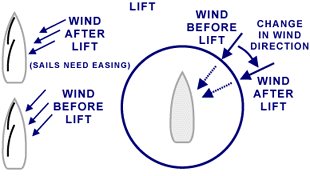Wind Shifts
It's important when sailing to be aware of the relative angle of the wind to the boat so that you can keep the sails in the right configuration for the particular wind angle. Sometimes you can have everything right but then the wind changes direction. When this happens, you will have to re-adjust Understanding the two kinds of wind shifts will help you adjust to them easily.
Header
When the wind changes to a direction more to the bow of the boat it is called a header. A header will usually cause the sails to luff. You can do either of two things to adjust for a header. One is to bear away until the boat has the original wind angle again. The other is to trim the sheets so that the sails are correct for the closer wind angle. If you are akeady sailing close hauled when you get a header, you can't trim any more. In this case, you can either bear away or come about.

Lift
When the wind shifts to a direction away from the bow, it is called a lift. When a lift happens, the sails will become over trimmed for the new wind angle. An over trimmed situation is more difficult to detect than a luffing situation. The way to be ready for a lift is by keeping an eye on the telltales so if a lift does occur, you will notice the change. You can adjust for a lift either by easing the sheets or by heading the boat up to meet the new wind angle. If you're not sure whether a lift has occurred, try easing the sheets anyway. When they are out too far, the sails will begin to luff. Then you can pull them back in to stop the luffing. Lifts are beneficial when you are beating to windward. They enable you to change your course to a direction closer to your destination.

Adjusting Sail Area for Changes in Wind Conditions (Reefing)
When sailing, there is continuous interaction between wind and sails. This interaction is what generates the power to move the boat. Speed, performance, and control are greatly influenced by the amount of sail area exposed to the wind. When the wind is light, the boat requires more sail area in order to perform properly. When there is strong wind, the boat requires less sail area If there is too much sail area the boat will be over-powered. In different wind conditions, the main sail is reduced by a technique called reefing. The area of the jib is usually adjusted by changing to a different jib or (if the boat has a furling jib rig) by furling some of the jib around the main stay.
A boat with too much sail area exposed for the wind condition will become hard to handle, and may even be forced out of control. The boat will also heel excessively. Excessive heeling forces more of the boat's hull surface area into the water. This also creates more friction and drag, slowing the boat. As the boat heels, less keel is presented to the water and this increases leeway. (sideways drift) Leeway greatly will affect upwind performance and pointing ability. Overpowering can also force the boat off course. The helmsman must compensate by holding the tiller to one side. The increased rudder angle will act as a brake, slowing the boat down and affecting control. A boat with too much sail area for the wind conditions will move slower, make the crew work harder, be less comfortable since it is heeling over more, and will be harder to keep on course. when the sail area is reduced, the excess wind pressure is relieved. The boat will sail easier, faster, and be easier to keep on course. Using reduced sail area does not make the crew "less able" sailors. There is nothing embarrassing about reducing the sail area. Reducing the Jib - In basic sailing, jibs can be changed by simply lowering and removing the existing jib, stowing it, and replacing it with the new jib. The fairleads may have to be re-positioned. Generally, the smaller the jib, the farther forward the fairleads have to be. Racers often have more complicated ways of changing jibs that minimize the amount of time under no headsail. And with furling jib rigs the area of the sail can be reduced by furling a part of the jib around main stay.